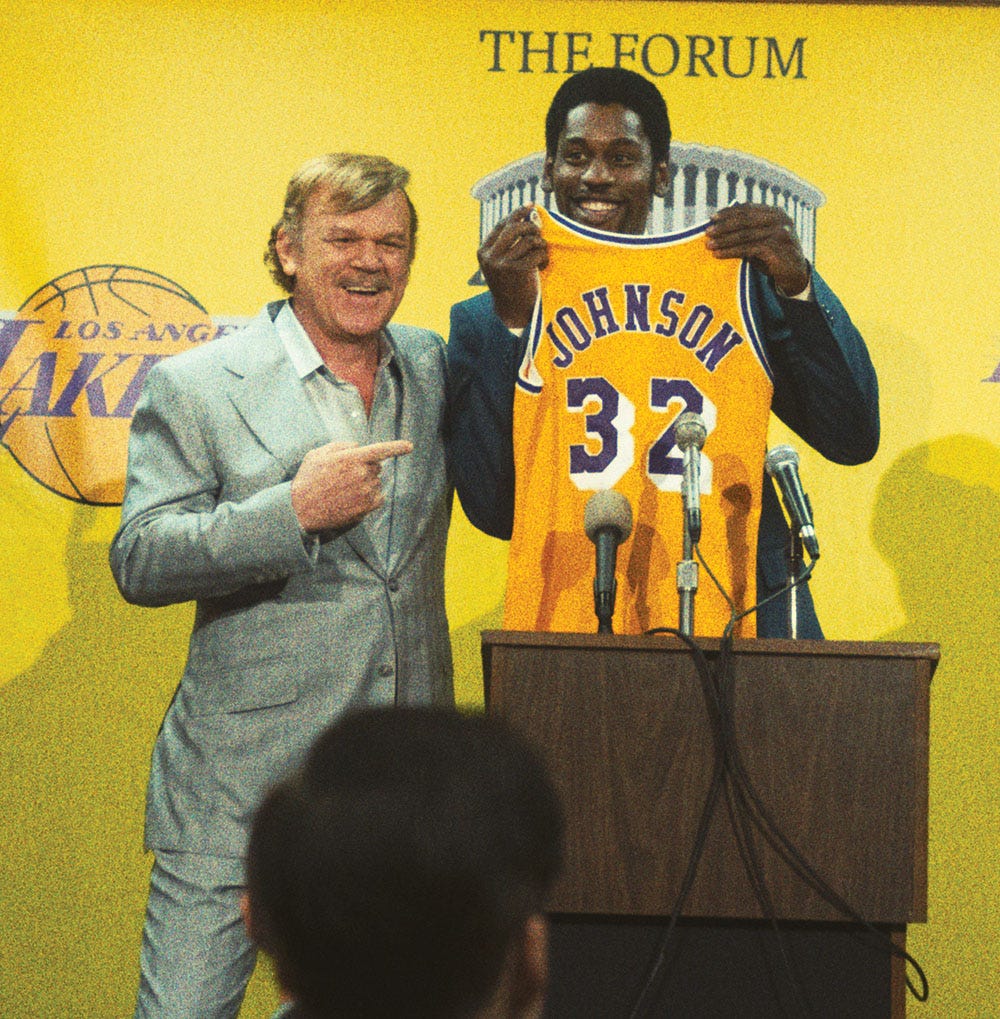Micah's Read of the Week, Vol. 83
The return of the 10-minute eviction, Jerry Jones & the Cowboys voyeurism scandal, Micah Recommends, Obit of the Week, Recipe Corner, and more.
Hello, and welcome to Micah’s Read of the Week.
This is a newsletter filled with things Micah Wiener finds interesting.
Check out the archive of previous newsletters here.
Please, subscribe and share with a friend.
The return of the 10-minute eviction
As the pandemic’s moratoriums come to an end, the man some call ‘Lock-’em-out Lennie’ is once again knocking on doors in Arizona
This is the most compelling piece I’ve read this year. It’s full of life, pain, excitement, intrigue, sadness, and more.
PHOENIX — The city’s last eviction moratorium of the pandemic had expired and the rent forgiveness program was running out of money, so Lennie McCloskey changed into his bulletproof vest and headed out to work. He climbed into his truck and counted through his daily stack of eviction orders. “Fifteen, sixteen — jeez Louise,” he said as he stacked them on the passenger seat. He strapped an extra magazine of ammunition to his belt and picked up his radio to call dispatch.
“Constable 33, heading out,” he said. “Looks like a busy day.”
“Okay,” the dispatcher said. “Guess it’s back to business as usual.”
Nobody in Phoenix was better or more practiced at the business of eviction than Lennie, who had personally removed more than 20,000 Arizonans from their homes during the past two decades as the area’s longest-serving elected constable. “Lock-’em-out Lennie,” colleagues occasionally called him, because the 65-year-old former judo champion was capable of coaxing tenants out of their homes with subtle intimidation or with grandfatherly kindness. He arrived at each apartment with treats to pacify dogs and stickers to give children. The tenants he ushered outside each day into their first moments of homelessness were often inconsolable, or defiant, or suicidal, or mentally ill, or violent and aggressive, but Lennie was calm. “You have to take your own emotions out of it,” he’d told colleagues during one national training. “It’s our job to carry out the court order.”
He put on his heavy-duty gloves, felt for his holstered firearm and knocked on the door. “Hello! Maricopa County constable,” he said. Inside he could hear whispering, a dog barking, and then silence.
He leaned against the door and listened to the sound of footsteps shuffling across the floor. For much of the past 20 months, Lennie had been working to keep people in their homes during the pandemic, brokering deals between landlords and tenants and connecting both sides with federal assistance programs during the moratorium, but lately he was back to doing several dozen evictions each week. It wasn’t yet the post-pandemic tsunami of evictions that some had predicted but rather a return to normal — except normal seemed different to Lennie now, more relentless and unpredictable. Landlords acted increasingly impatient after months of falling behind on their collections. Tenants were more resistant to leaving their homes after months of government assistance. And Lennie could feel his own behavior shifting, too, in ways he was still trying to understand. “It’s not like I’ve gone soft, but maybe a little bit more lenient,” he said. “More compassionate or understanding.”
He waited at the entryway for a few more seconds, took out his baton, and started banging on the door.
“Hello!” he shouted. “Maricopa County peace officer! Open up now!”
But no matter who he found waiting inside, Lennie’s job remained the same: to search the home, force everyone out and change the locks — all within a government-recommended time of about 10 minutes.
Now the apartment door swung open in front of him, and this time what Lennie saw was a shirtless, middle-aged man holding a half-eaten bowl of cereal. The dark apartment behind him was cluttered with cardboard boxes, broken furniture and open piles of trash. “Can I help you?” the man asked.
“Good morning,” Lennie said. “I’m here because I have a court order that says by law I need to evict you out of here.”
The man glanced at Lennie’s badge and then down at his gun. “Uh-huh. Okay,” he said. He took a few bites of cereal while Lennie waited.
“Sorry, but we don’t have much time,” Lennie said.
“Oh, you mean I’m getting evicted today?” the man said. “Right now?”
Lennie nodded. “You can make an appointment with the landlord to come get your things later, but we only have a few minutes before we change the locks. Grab any essentials you can’t live without.”
“Just the essentials,” Lennie repeated. “Medications. Pets. Walking shoes. Photo albums. Car keys. A change of clothes.”
The tenants began stuffing T-shirts into a backpack. Lennie checked his watch as the building’s maintenance worker started to change the locks. “We about ready?” Lennie asked the tenants a few moments later, and when nobody answered he tried again. “Time to wrap up,” he said, and eventually the tenants walked out of the apartment with the backpack, a Chihuahua, a small TV and a box fan.
“Good luck,” Lennie said as he closed the door behind them. He locked the deadbolt. He shook the door handle to test the new lock. He looked down at his watch: nine minutes.
“Okay. One down,” he told the maintenance worker. “Who’s next?”
Next it was a mother and her two children, ages 6 and 13, gathered in front of their dryer. “I need to finish this load,” the mother told Lennie, and he nodded and reached into his pocket for a referral card to a local shelter. “Maybe they can help,” Lennie said.
“I tried that,” she said. “I tried everything.”
“Do you have anywhere to go?” he asked.
“Does it matter?”
“The law says I have to carry out this order,” Lennie said. “But yeah. It matters to me.”
She grabbed the load of laundry and pointed her kids to a Toyota in the parking lot. “We’ll be in the car for a few days,” she said.
Eight minutes. Eleven minutes. Four minutes. Six minutes. “They’re over fast but sometimes you keep thinking about them,” Lennie said as he climbed back into his truck and headed toward his ninth eviction of the morning, at a newer apartment complex. He pulled into the parking lot and ate a power bar. He sat in the car for an extra moment with his mask off, taking deep breaths, but then the property manager came up to his window and waved.
Compelling stuff. Guess what? It actually gets more heartwrenching.
He followed the property manager through the courtyard to a two-bedroom apartment with an entry mat that read: “Welcome! Friends Gather Here.” On the porch Lennie noticed a small collection of toy trucks and a child’s fairy garden built from straw dolls and succulent plants. “Oh no,” he said, and he shut his eyes for a moment and then knocked, until a man wearing a collared shirt and a carrying briefcase answered the door.
“Hi,” Lennie said. “Ricardo Hernandez?”
“Yes, sir. Can I help you? I’m just leaving for work.”
“I’m sorry to say I’ve got a court order for eviction. I’m here to ask you to leave.”
A little girl came up from behind Ricardo and grabbed onto his leg. Lennie waved to her. She looked up at his bulletproof vest and then hid behind her father and started to cry. “Oh no. It’s okay, sweetheart,” Lennie said. He reached into his pocket and felt beyond the handcuff keys and the flashlight and the absorbent medical gauze for his collection of sheriff-badge stickers, and then he held one out toward her.
“Come on, really?” Ricardo said, glaring first at the sticker and then at Lennie.
Lennie shrugged. “Kids love stickers,” he said, and the girl took it and put it on her dress. Lennie gave her a thumbs-up and turned back to Ricardo.
“I know this is hard,” he said. “We’ll give you a few minutes to get your personal items.”
“We’ve got three kids,” Ricardo said. “We’ve been here three years and never caused any trouble. Our rent was getting paid, but I’ve been late because of this whole pandemic.”
“And I believe you,” Lennie said. “But, unfortunately, that doesn’t stop the eviction.”
“I have the money,” Ricardo said.
Lennie looked down at the eviction paperwork. “Says here the judgment is for $2,300.”
“I’m telling you, I have the money,” Ricardo said, and Lennie nodded and looked at him for a long moment.
“Okay,” he said. “If the property manager lets you pay up now, I’m good with that. That would be good for everybody.”
“Believe it or not, I’ve been there,” Lennie said, and he told Ricardo about how his side business as an electrician had suffered during the economic collapse in 2008, just as he and his wife were preparing to adopt a son. He’d fallen so far behind on his mortgage that one afternoon he’d returned home from a day of doing evictions to find a foreclosure notice taped to his own front door, and then he’d barely scrambled together enough money in savings and loans to keep his home.
“We’re all a few bad breaks away,” Lennie told the property manager as they sat down in her office. “If Ricardo here is able to pay up in full, can he stay?”
Spoiler alert: he was unable to pay. Lennie returned the next day.
“Did we get a happy ending?” he asked the property manager.
“Depends,” she said, and then she explained that she’d received no payment and no more information from Ricardo, so she’d already rented out his unit, increasing the price from $1,700 to $2,200, and a new tenant had snapped it up within 15 minutes. “Demand right now is off the chain,” she said. “We need him out. We need to proceed.” Lennie sighed, nodded and followed the locksmith back down the gravel pathways to Ricardo’s porch.
Ricardo crossed his arms, stared at Lennie for a moment, and then nodded. “Okay. Ten minutes,” he said, and then he began hurrying through the house to find all the essentials necessary for a 7-year-old, a 4-year-old, a 1-year-old and a dog.
To Lennie the final 10 minutes inside someone else’s home usually felt interminable. There was little for him to do and nothing helpful he could say, so he stood in a corner and tried to make polite conversation as he encouraged things along.
“I like this lamp,” he told Ricardo.
“Huh?” Ricardo said, as he came out of the bathroom carrying five toothbrushes and then followed Lennie’s gaze to a floor lamp in the living room. “Oh, yeah. Thanks.”
“Where’d you get it?”
“Costco,” Ricardo said as he packed the toothbrushes into a travel case.
“No kidding?” Lennie said. “I should go get one of those.”
“I’ll sell it to you,” Ricardo said. “How about $6,200?”
“I’m sorry,” Lennie said, but the moratorium was over and that meant it was also routine. He watched them drive away, double-checked the locks, and then continued to the next address on his list.
New Yorker Cartoon of the Week
Jerry Jones Can’t Hide From the Cowboys Voyeurism Scandal
The owner of the NFL’s most valuable franchise is no stranger to controversy. But this time, Jones and his organization have never looked worse.
The great Richard Justice, writing for Texas Monthly puts Jerry in a bodybag.
Until now, the standard image of Dallas Cowboys owner Jerry Jones that has existed in NFL fans’ heads has been that of a cartoonish carnival barker, shameless pitchman, and bumbling football executive. Even as he dotted his roster with a smorgasbord of bad actors over the years, Jones seemed harmless enough when he’d flash his toothy, hillbilly smile and offer rambling explanations for his decisions that sometimes bordered on indecipherable.
Besides, he understood the often amoral nature of sports fandom. He knew that many supporters didn’t really care—or found it convenient to ignore—that a player had a history of violence against women, had gotten behind the wheel of a car while drunk, or had used recreational drugs. Just win, baby.
One of Jones’s highest-ranking executives is accused of recording images of a group of cheerleaders as they changed clothes. Even worse, Jones appears to have covered for the executive for over six years. When ESPN began asking questions, the executive, Rich Dalrymple, announced his retirement.
By now, you’ve probably heard about this story, but a little background:
Here’s ESPN’s bombshell opening paragraph: “The Dallas Cowboys paid a confidential settlement of $2.4 million after four members of their iconic cheerleading squad accused a senior team executive of voyeurism in their locker room as they undressed during a 2015 event at AT&T Stadium, according to documents obtained by ESPN and people with knowledge of the situation.”
Justice takes no prisoners.
This isn’t Jones signing cornerback Pacman Jones and his lengthy arrest record. Nor is it signing defensive lineman Greg Hardy despite the domestic violence accusations against him.
This time, it’s darker. There can be no “boys will be boys” excuses. This time, the brand that is the Dallas Cowboys, the brand that made the organization the most valuable franchise in professional sports, the brand that delivers gargantuan television ratings—that brand could be stained in a way it has never been stained before.
If this were a single incident of alleged misconduct by an employee, that would be one thing. Even after Jones learned that Dalrymple had been accused of—and identified as—sneaking into a room to apparently shoot video or snap photos of a group of cheerleaders as they changed clothes, even after the team paid millions to make the case go away, Dalrymple, who has denied wrongdoing, remained at Jones’s side for another six years.
Jones took no substantive action except—wait for it—to revoke Dalrymple’s access to cheerleader dressing areas. Seriously? Rather than reporting the incident to the police, the Cowboys are said to have conducted their own investigation. This is laughable.
This we know: the Cowboys will roll on, and Jerry Jones, 79, will remain at the helm until he passes his $10 billion empire to his three children, all of whom are involved in Cowboys management.
In the last decade, the NFL media machine has moved on from all sorts of bad news, ranging from brain trauma to sexual assault to racism. The league will almost certainly plow right through this scandal, too. Before long, fans will have moved on and forgotten about Rich Dalrymple’s alleged voyeurism and the Cowboys’ apparent efforts to conceal the incident from public attention. That’s what the team wants, and that’s what the league wants.
And Jerry Jones had better hope that’s what happens, because he has never looked worse.
Micah Recommends
“Rock ‘n Soul, Part 1 & 2” of Slate’s Hit Parade Podcast
Daryl Hall and John Oates: Their songs were earworms, their videos cheap and goofy. John Oates’ mustache and Daryl Hall’s mullet are relics of their time. And … for about five years, their crazy streak on the pop charts was comparable to Elvis, the Beatles, and the Bee Gees.
They were also more cutting-edge than you may realize, essentially inventing their own form of cross-racial new wave after spending the ’70s trying everything: rock, R&B, folk, funk, even disco. At their Imperial peak in the early ’80s, Hall and Oates commanded the pop, soul, and dance charts while still getting played on rock stations. And decades later, when the Rock & Roll Hall of Fame ignored them, it was Black artists—rappers and soul fans—who pushed them in.
Everybody knows I’m a huge H&O guy. Huge. I’ve been Daryl and John at least a half dozen times, and they always deliver. This podcast is a comprehensive look at their career and influence. I highly recommend it.
Mind of Micah Podcast
Ok, so it’s kind of cheating to promote my own podcast, but I think you’re really gonna like this week’s episodes. We talk about how HBO’s Lakers Series Ticked Off the NBA, Ended a Friendship and Became the Most Anticipated Sports Show in Decades.
You’ll enjoy it. Subscribe now and get the new episodes as soon as they are released.
Obit of the Week
Ok, here’s a new one: this woman wrote her own obit as a resume for heaven. Truthfully, it’s pretty strong. Good for her.
BEATRICE FEDIUK
(nee HAMEL)
October 22, 1927 - February 12, 2022
Dear Lord,
Please accept my application for Eternal Life. My resumé is as follows:
Objectives: To be honest and compassionate; to treat everyone with respect; to demonstrate integrity in all I do, and to live as independently as possible, as long as possible.
References:
I was born in Fannystelle to loving parents, Eugenie (Painchaud) and Alfred Hamel, who already had six other children: Aime (Juliette), Blanche (Peter), John (Gladys), Vincent (aka Bill) (Mae), Martin and Flore (Hjalmer). They, along with my nephew Guy, and my husband John are already with you in Heaven and can provide references for me.
Training:
I went on to obtain my teaching certificate at Normal School and began my career working with children in 1948; first in Swan Lake, then in Tyndall. It was there that I met the love of my life, John, and we were married in June 1951. Our one and only daughter, Michelle was born 11 years later.
Experience:
We settled in Winnipeg, where I held teaching positions in Tuxedo, River Heights, then Aberdeen, Sargent Park, Earl Grey and La Verendrye. Lord, you know that I never had any "teacher's pets", for gifted children already have a greater chance of success. Rather, I put my heart into teaching those with learning challenges, or difficult family situations. It was here that I feel I did my best work.
Volunteer Work:
Throughout my life, I volunteered at St. Ignatius Parish as well as with the Manitoba Music Festival. After retiring, I continued to volunteer with children who needed extra help and was known as "Aunty Bea" in St. Ignatius and Rockwood, as well as Central Middle School in Weslaco Texas.
When it was discovered that our granddaughter had an intellectual disability, I redirected my efforts to educating myself about her diagnosis, so I could support her in achieving her goals. And Lord, she taught me more about what is important in life than I ever taught her.
Hobbies:
Over the years, I cared for many fur babies, including Bozo, Bimbo, and Bijou I and II. I was grandma to Nanuq and great-grandma to Epi.
I loved to travel and made trips to Hawaii, Alaska, Florida, and California with my family. John and I were "Winter Texans" for over 10 years and enjoyed socializing with friends and family in Magic Valley.
In addition, I knitted scarves for underprivileged children and Prayer shawls for the sick and dying.
Lord, I hope that you will find that I have met my Objectives and deserve a place in Your heavenly home. You know where to find me to further discuss my qualifications.
Rest in peace.
Recipe Corner
The World’s Easiest Winter Cocktail
Let’s start with a cocktail that is perfect for peak citrus szn. You have to use fresh-squeezed grapefruit juice, or fear the wrath of your local mixology expert.
Before slinging mai tais at Austin’s newest hit bar Tiki Tatsu-Ya, Cory Starr worked at Three Dots and a Dash, a tiki bar in Chicago.
The Salty Dog
2 ounces vodka of your choice
4 ounces fresh-squeezed grapefruit juice
Yukari (or any salt variation) for the rim
Shiso leaf for garnish
Rim a Collins glass with yukari. Fill the glass with cubed ice. Add vodka and juice, and give it a quick stir to incorporate. Finish with a shiso leaf on top.
Caramelized Black Pepper Chicken
Easy weeknight meal alert.
1/2 cup dark brown sugar
About 1/4 cup fish sauce (nam pla)
1/4 cup water
3 tablespoons rice vinegar
1 teaspoon minced garlic
1 teaspoon finely grated fresh ginger
1 teaspoon coarsely ground pepper
2 fresh Thai chiles, halved, or dried red chiles
1 tablespoon canola oil
1 shallot, thinly sliced
1 pound skinless, boneless chicken thighs, cut into 1-inch pieces
4 cilantro sprigs
In a small bowl, combine the sugar, fish sauce, water, rice vinegar, garlic, ginger, pepper and chiles.
Heat the oil in a large deep skillet. Add the shallot and cook over moderate heat until softened, about 4 minutes. Add the fish sauce mixture and the chicken and simmer over high heat until the chicken is cooked through, about 10 minutes. Transfer to a serving bowl, garnish with the cilantro and serve.
Radicchio and Red Grapefruit Salad
And here’s another citrus szn special. This would make a great salad to eat all week.
1/4 cup (1 ounce) walnut pieces
1 large red grapefruit
2 tablespoons extra-virgin olive oil
1 tablespoon balsamic vinegar
1 teaspoon honey
1/4 teaspoon fine salt
1/4 teaspoon freshly ground black pepper
3 cups lightly packed, torn radicchio leaves (1 head)
1/4 small red onion, thinly sliced into rings (12 slices)
2 ounces soft goat cheese (chevre)
In a small dry skillet over medium heat, toast the walnuts, tossing or stirring frequently, until fragrant, 3 to 5 minutes. Remove from the heat, transfer to a small bowl and let cool.
Using a sharp paring knife, trim the top and bottom off the grapefruit. Stand it on one end and, cutting downward following the curve of the fruit, remove all the rind and white pith. Hold the fruit over a medium bowl and cut each grapefruit segment from its membrane, letting the segment drop into the bowl. Squeeze any juice from the remaining membrane into a small bowl or jar.
In another medium bowl, whisk together the oil, vinegar, honey, salt, pepper and 1 tablespoon of the grapefruit juice. (Reserve the remaining juice for another use, such as drinking it.) Add the radicchio to the bowl with the dressing and toss to coat.
To serve, arrange about 3/4 cup of the radicchio onto each plate then evenly divide the grapefruit segments, onion, goat cheese and the walnuts over each portion. You can also arrange the salad in a large salad bowl and serve it family-style.
Financiers (Almond–Browned Butter Cakes)
How about an easy, 5-ingredient dessert that would be a lovely accompaniment to your morning coffee the rest of the week?
5 tablespoons unsalted butter
¾ cup (3 ounces) finely ground almond flour
½ cup plus 1 tablespoon (4 ounces) sugar
2 tablespoons all-purpose flour
⅛ teaspoon table salt
⅓ cup (3 ounces) egg whites (3 to 4 large eggs)
Adjust oven rack to middle position and heat oven to 375 degrees. Generously spray 24-cup mini-muffin tin with baking spray with flour. Melt butter in 10-inch skillet over medium-high heat. Cook, stirring and scraping skillet constantly with rubber spatula, until milk solids are dark golden brown and butter has nutty aroma, 1 to 3 minutes. Immediately transfer butter to heatproof bowl.
Whisk almond flour, sugar, all-purpose flour, and salt together in second bowl. Add egg whites. Using rubber spatula, stir until combined, mashing any lumps against side of bowl until mixture is smooth. Stir in butter until incorporated. Distribute batter evenly among prepared muffin cups (cups will be about half full).
Bake until edges are well browned and tops are golden, about 14 minutes, rotating muffin tin halfway through baking. Remove tin from oven and immediately invert wire rack on top of tin. Invert rack and tin; carefully remove tin. Turn cakes right side up and let cool for at least 20 minutes before serving.
Did Micah practice yoga this week?
Yes. 60 minutes Saturday at Black Swan Yoga. That’s 7 weekend classes in 8 weeks this year. Namaste.
More Micah
Podcasts: Mind of Micah, Back Door Cover, Too Much Dip
Twitter: @micahwiener & @producermicah (Why two twitters? It’s a long story)
Mortgage Inquiries: savewithmicah.com
Instagram: @micahwiener
LinkedIn: @micahwiener
Peloton: #badboysofpelly @micahwiener
Email: micahwiener@me.com
NMLS #2090158, equal housing lender.










